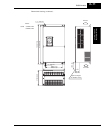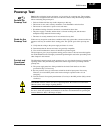
SJ300 Inverter
Inverter Mounting
and Installation
2–19
NOTE: An inverter powered by a portable or emergency diesel power generator may result in a
distorted power waveform, overheating the generator. In general, the generator capacity should
be at least five times that of the inverter (kVA).
CAUTION: Be sure that the input voltage matches the inverter specifications:
• Three phase 200 to 240V 50/60Hz
• Three phase 380 to 480V 50/60Hz
CAUTION: Be sure not to power a three-phase-only inverter with single phase power. Other-
wise, there is the possibility of damage to the inverter and the danger of fire.
CAUTION: Be sure not to connect an AC power supply to the output terminals. Otherwise,
there is the possibility of damage to the inverter and the danger of injury and/or fire.
CAUTION: Remarks for using ground fault interrupter breakers in the main power supply:
Adjustable frequency inverters with CE-filters (RFI-filter) and shielded (screened) motor
cables have a higher leakage current toward Earth GND. Especially at the moment of switching
ON this can cause an inadvertent trip of ground fault interrupter breakers. Because of the recti-
fier on the input side of the inverter there is the possibility to stall the switch-off function
through small amounts of DC current. Please observe the following:
• Use only short time-invariant and pulse current-sensitive ground fault interrupter
breakers with higher trigger current.
• Other components should be secured with separate ground fault interrupter breakers.
• Ground fault interrupter breakers in the power input wiring of an inverter are not an
absolute protection against electric shock.
CAUTION: Be sure to install a fuse in each phase of the main power supply to the inverter.
Otherwise, there is the danger of fire.
CAUTION: For motor leads, ground fault interrupter breakers and electromagnetic contac-
tors, be sure to size these components properly (each must have the capacity for rated current
and voltage). Otherwise, there is the danger of fire.
Power Output
RST
T1 T2 T3
UVW
L1 L3
NOTE:
L1, L2, L3:
Three-phase 200 to 240V 50/60 Hz
Three-phase 380 to 480V 50/60 Hz
L2
Power Input


















